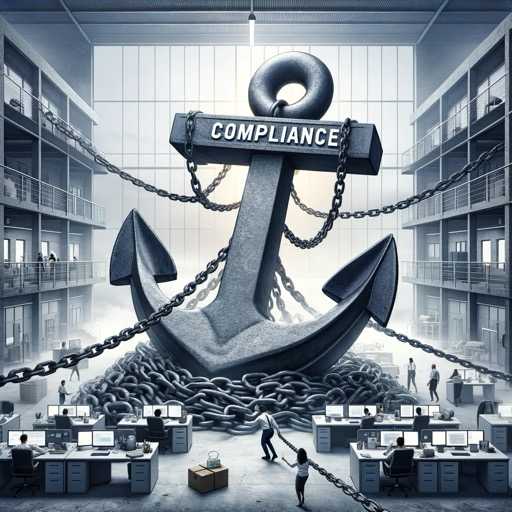Do you ensure compliance and governance without compromising agility?
Last updated by Gert Marx [SSW] about 1 month ago.See historyAs your organization scales up its Agile practices, you're navigating a complex landscape. On one side, there's the rigorous terrain of regulatory requirements and governance structures – necessary for maintaining standards and accountability. On the other, there's the open field of agility, the very force that's propelling your organization's success.
This presents a critical balancing act. How do you adhere to essential regulations and governance without putting the brakes on the agility that gives your organization its edge?
Finding this equilibrium is not just beneficial – it's vital for sustainable growth in a compliant and dynamic environment.
What Does It Mean to Balance Compliance and Agility?
Balancing compliance and agility is a strategic endeavor that requires crafting a governance framework with a dual focus. On one hand, this framework must be robust enough to ensure adherence to necessary regulatory standards – a non-negotiable aspect for any organization. On the other, it needs to be flexible enough to allow teams to retain their agile mindset and practices.
Achieving this balance means establishing processes and guidelines that provide structure without rigidity, ensuring compliance without curtailing the dynamic, adaptive qualities that drive agile success. It’s about creating an environment where regulation and agility coexist, complementing rather than conflicting with each other.
Benefits of Balancing Compliance and Agility
Risk Mitigation
Balancing compliance and agility doesn't just help the organization meet its legal and regulatory requirements – it's a comprehensive risk mitigation strategy. By ensuring adherence to these standards, the organization not only avoids legal pitfalls and financial penalties but also safeguards its reputation and stakeholder trust.
This aspect of risk mitigation is crucial in today’s business environment, where non-compliance can have far-reaching consequences. Simultaneously, maintaining agility within this compliance framework ensures that the organization remains dynamic and responsive, capable of quickly adapting to changing regulations and market conditions. Thus, this balance acts as a dual shield, protecting the organization legally and competitively.
Operational Efficiency
Striking a balance between compliance and agility paves the way for enhanced operational efficiency. In this framework, teams are empowered to be agile and responsive, navigating their tasks and projects with the necessary freedom to innovate and adapt. At the same time, they are not encumbered by excessive controls or rigid procedures that can stifle creativity and responsiveness.
This equilibrium ensures that the agility of teams is not sacrificed in the name of compliance. Instead, it fosters an environment where teams can operate efficiently within a well-defined, yet flexible, governance structure. The result is a streamlined workflow that upholds compliance standards without dampening the agile spirit that drives productivity and continuous improvement.
Business Alignment
Balancing compliance with agility plays a critical role in aligning both governance structures and agile practices with the overarching business objectives. This alignment is key to ensuring that every regulatory measure and agile initiative not only coexists but also collaboratively drives the organization towards its strategic goals.
By harmonizing these elements, the organization ensures that its pursuit of agility enhances, rather than detracts from, its compliance obligations.
This synergy between governance and agility underpins a unified approach, where decisions and processes are consistently and strategically geared towards advancing the business's mission and vision. In doing so, it guarantees that the organization remains on a path that is both compliant and conducive to growth and innovation.
Balance compliance and governance with agility to achieve both operational efficiency and risk mitigation.
Figure: Good example - A balanced approach allows for agility within the boundaries of compliance and governance
Why Should You Balance Compliance and Agility?
Regulatory Peace of Mind
Adopting a balanced approach between compliance and agility offers more than just a tactical advantage; it provides a sense of security and peace of mind in regulatory matters. This equilibrium ensures that while the organization is moving swiftly and adapting to market demands with agility, it is not doing so at the cost of compliance. By having clear, agile-friendly compliance processes in place, the organization can confidently navigate the regulatory landscape.
This confidence extends beyond just meeting the minimum legal requirements; it encompasses a comprehensive understanding and integration of regulatory considerations into everyday agile practices. The result is a proactive stance towards compliance, where regulatory peace of mind becomes a pillar of the organization’s strategy, allowing it to focus on innovation and growth without the looming worry of compliance breaches.
Achieve regulatory peace of mind without compromising agility.

Business Agility
Ensuring that compliance and governance do not hinder your agility is fundamental to achieving true business agility.
In today's rapidly evolving market landscape, this agility translates into a tangible competitive advantage. It enables your organization to respond with alacrity to new opportunities, shifts in consumer demand, and emerging industry trends.
By finding the right balance, your organization is not just adhering to necessary regulations but is also positioned to pivot and innovate at a moment's notice. This responsiveness is crucial for staying ahead in a dynamic business environment, allowing you to capitalize on opportunities and navigate challenges more effectively than ever before.
Maintain business agility while adhering to governance requirements.

Conclusion
Navigating the tightrope between ensuring compliance and governance, and preserving agility, is undoubtedly a challenging endeavor, yet it is essential for the modern organization.
A balanced approach in this regard is not just a best practice, but a strategic necessity. It enables organizations to confidently meet regulatory requirements while retaining the indispensable flexibility to adapt, evolve, and innovate in a fast-paced business environment.
This balance is key to building an organization that is not only compliant and responsible but also dynamic and forward-looking. In essence, by achieving this equilibrium, organizations set themselves up for sustainable success, adeptly positioned to meet the demands of both today and tomorrow.

